Everything You Need to Know About Facebook CAPI Integration for Salesforce
Written by: EasyAutoTagging Staff Read time 3 minutes
Advertising on Facebook has become an essential part of any digital marketing strategy due to its extensive targeting options, large user base, and advanced analytics. However, to ensure maximum ROI from your B2B Facebook ads, it’s crucial to have a reliable and robust data integration system in place. This is where Facebook CAPI Integration (Conversion API) comes in. In this blog post, we will explore what CAPI is, its integration with Salesforce, and how it can improve your B2B Facebook ad performance. Additionally, we will introduce ConversionStream, a platform that enables you to implement CAPI for Salesforce without requiring engineering support.
Overview:
- What is CAPI?
- How does the Facebook CAPI Integration work with Facebook Ads?
- How does the CAPI Integration work with Salesforce?
- Benefits of using the Facebook CAPI Integration and Salesforce
- Conclusion
What is CAPI?

CAPI stands for Conversion API, an API solution offered by Facebook to help businesses track their website’s conversions and events. It works by sending data directly from your source of truth i.e. Salesforce to Facebook’s servers, instead of relying on browser-based tracking methods such as cookies. This makes it a more reliable way to track conversions, especially on mobile devices and in scenarios where cookies are not supported.
How does the Facebook CAPI Integration work with Facebook Ads?
CAPI is essentially a reverse ETL process that can help you better track performance and optimize your Facebook ads. By using Facebook’s Conversion API (CAPI) to send server-to-server conversions, businesses can benefit from more reliable and accurate tracking of website events and purchases. Unlike cookie-based tracking, CAPI sends data directly from Salesforce to Facebook’s servers, ensuring that no critical events go untracked. This provides a more accurate view of your ad performance and improves performance optimization with higher-quality conversion signals. Additionally, by integrating CAPI with Salesforce you can leverage customer data to improve performance and increase B2B lead quality. Overall, using CAPI can help you maximize your Facebook ad results and boost your ROI.
How does the CAPI Integration work with Salesforce?
With ConversionStream you can integrate Facebook CAPI with Salesforce to provide a more comprehensive view of customer data. By integrating CAPI with Salesforce, you can:
- Track sales conversions: By sending INQ, MQL, SQL, and OPP data from Salesforce to Facebook, you can track which ads and campaigns drive the most value for your business and optimize campaigns with high-quality intent signals.
- Create custom audiences based on Salesforce data: CAPI allows you to create custom audiences based on data from your Salesforce CRM, using object-level fields to filter and sort your audiences.
- Improve ad targeting: By combining Salesforce conversion data with Facebook’s targeting options, you can create more effective and targeted ads that resonate with your audience.
Facebook CAPI does take engineering support to implement. However, with ConversionStream you can send conversions and audiences directly with our Salesforce Facebook Ads integration.
Benefits of using the Facebook CAPI Integration and Salesforce
There are several benefits of using CAPI with Facebook Ads and Salesforce, including:
- More accurate tracking: CAPI can provide more accurate tracking of website events and conversions, especially on mobile devices.
- Better ad targeting: By combining conversion data from Salesforce with Facebook’s targeting options, you can create more relevant and compelling ads.
- Improved ad performance: By using CAPI, you can optimize your ad delivery and improve your ad performance by allowing Facebook to use high-quality conversion data directly from Salesforce to optimize your campaigns.
Facebook CAPI Integration Case Studies
Facebook has and is pushing the adoption of the Conversion API to the extent that they offer advertisers technical and engineering support to get the Conversion API implemented. You can see the results across B2B lead gen brands on their case study page and here are some examples.

Conclusion
In conclusion, CAPI can be a powerful tool for businesses looking to improve their Facebook ad performance. By using Facebook’s Conversion API (CAPI) to send server-to-server conversions from Salesforce, businesses can benefit from more reliable and accurate tracking of high-quality conversion signals. Unlike traditional pixel-based tracking, CAPI sends data directly from Salesforce to Facebook’s servers.
Integrating the Facebook CAPI integration with Salesforce can give you a comprehensive view of customer data, allowing you to create more effective and targeted ads. To streamline this process, we recommend using ConversionStream. By using ConversionStream, you can easily track Salesforce conversion events in Facebook Ads and optimize your ad performance. Start using ConversionStream today to boost your Facebook ad ROI!
AUTHOR BIO:

The EasyAutoTagging staff is made up of seasoned pros in digital marketing, marketing analytics, and ad tech. They’ve brought a wealth of experience and hands-on knowledge to our blog and help documentation over the years. From in-depth articles on the latest industry trends to easy-to-follow guides. You can explore more of their articles here.
Leave a comment